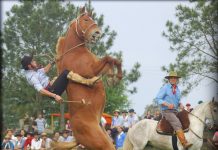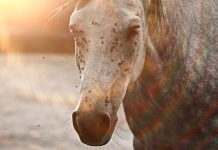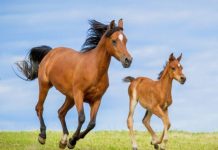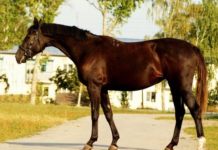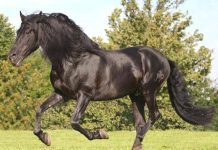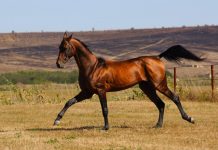The Polish Warmblood breed is relatively young. It wasn’t until the 1960s that breeding began. It has not yet been bred in Germany. However, the stallions of the Polish Warmblood are used to refine German horse breeds.
The beautiful and versatile animals inspire every rider. The most common are browns, blacks, and foxes. You rarely find piebalds and molds in the Polish warmblood. The horses of this breed have toughness and robust health.
The article provides information about the history of the breed, the characteristics of the exterior and interior, the keeping and care of the Polish Warmblood.
You will receive advice on the upbringing, nutrition, and health of the Polish Warmblood breed.
Breed description

The Polish Warmblood breed is also called Wielkopolski. The name comes from the Greater Poland Voivodeship (Wielkopolskie) near the city of Poznan in Poland.
This area is the main breeding area for the Polish Warmblood breed. The young breed impresses with many positive characteristics, great performance, and a noble appearance.
Polish Warmblood horses are popular in Poland. There they also have many successes in eventing and driving. The breed is rare in Europe.
Size: 162-168 cm
Weight: 450 – 600 kg
Origin: Poland
Lifespan: 20-30 years
Color: Mostly brown, all colors possible, including piebalds
Suitable as: Free time, jumping
Origin and breed history
Horse breeding in the eastern Polish region has a long tradition. Various horse breeds have been bred there since the 13th century, above all the Trakehner.
The Polish Warmblood breed is very young. Your ancestors are old. The breeding of the Trakehner could not be continued from 1944. The main stud was evacuated to Prussia and Mecklenburg-Western Pomerania.
Some horses reached the western occupation zones on refugee trails. The Trakehner horses that remained in Poland were used as starting horses for the Masurian breeding.
Another popular horse breed in eastern Poland was the Poznan. Both breeds had strong Arab and thoroughbred genes. The Poles have always preferred an Arabian type of horse. Koniks belongs to the ancestors of the Poznan people who served as farm horses.
In the 1960s, both breeds were combined as the “Wielkopolska Horse” (Polish: Kon wielkopolski). In order to maintain the gene pool, small breedings of the respective breeds continued to exist for some time.
Today Masurian horses and Poznan horses are considered to be extinct. From around 1970, the Polish Warmblood breed showed uniform traits. There are two variants of the breed: light as a sport horse and a heavy warmblood as an economic horse.
Since then, the Polish Warmblood breed has been bred in thirteen state studs. Thoroughbreds were sometimes included in the breeding. The five studs concentrate exclusively on sport horses.
The Polish Warmblood breed quickly gained great popularity and became an important economic factor.
The ancestors of the Polish Warmblood breed include:
- Trakehner
- Masurian horse
- Konik
- Poznan
- English blood
- Arabian thoroughbred
- Hanoverian
The appearance of the Polish Warmblood
The Polish Warmblood breed shows a noble, elegant and sporty appearance. The large-framed horses have a rectangular building with harmonious proportions.
That means your legs are long, the ratio of the length of your back to the length of your legs is a rectangle. The well-formed, dry head shows a straight profile with a noble expression.
The big eyes are lively. The nostrils are large, the ears small. The slightly curved, medium-length neck is well set.
The Polish Warmblood breed shows a light, thin neck. The withers are at a height of 162 cm to 168 cm and are sufficiently pronounced. The shoulders are well set, long, and sloping. The back has an ideal saddle position.
It’s straight and long. The well-muscled croup falls off slightly. The compact hull is moderately wide, deep and a little tucked up on the flanks.
The stable foundation shows medium strength. The legs are dry, the tendons are clearly visible, the joints are well developed and the hindquarters are clearly muscular.
The long, sloping shackles have light curtains. The beautifully shaped hooves are strong. The sporty type of the Polish Warmblood breed is more delicate and elegant.
The heavy warmblood type shows a stronger physique. The weight is between 500 kg and 600 kg. The coat of the Polish Warmblood breed comes in all colors.
The most common are brown and dark brown. Mold, black horses, foxes, and piebalds are less common. Polish Warmblood animals often have white markings on their heads and legs.
These are allowed to a small extent. The long hair on the mane and tail is fine.
Temperament and essence
Polish Warmblood horses have a balanced character with a lively temperament. The humans-related animals are intelligent and willing to perform.
You can teach them a lot because they love to learn. Their reliability and willingness to work make these horses very versatile animals. They mostly show their gentle side.
However, some individuals may be startled or nervous. In the character of a horse, both disposition and personal experiences play a role.
Other animals of the Polish Warmblood breed have strong nerves and courage. All horses of the Polish Warmblood breed have great endurance.
You can go on long rides at a brisk pace through the terrain with them without any problems. Characteristically, in the sporty type of the Polish Warmblood breed, the whole blood content sometimes shows through.
Then they show their temper. The heavy warmblood has a consistently balanced, very good character.
Husbandry and nutrition

Attitude
Polish Warmblood horses are very easy to ride. All gaits are correct and energetic. These horses want to be moved. In terms of their external disposition, they can successfully master a great many disciplines.
The more sporty type of the Polish Warmblood breed has a greater jumping ability, can gallop longer and faster, and shows a long, flat trot.
Combined with mental strength and courage, horses with these characteristics are particularly suitable as show jumpers. In the versatility, they can also implement their physical and mental prerequisites in the best possible way.
The heavy warmblood, on the other hand, is predestined as a light workhorse or as a driving horse. Here, too, strong nerves, a relaxed mind, and great endurance are the best prerequisites. In dressage, horses of the Polish Warmblood breed are used less often.
Nevertheless, they can also record successes there. If you train your horse accordingly, you can use it well as a western horse. Last but not least, the male animals of the Polish Warmblood serve as breeding stallions for the refinement of other breeds.
This also includes some German races. Few other horse breeds in the world show such a great diversity. When it comes to animals, it depends on what you want to do with the horse. Whether it is kept in an open stable, pasture or box ultimately also depends on your financial and spatial possibilities.
And of course your preferences. If you have a very noble sport horse of the Polish Warmblood breed, you may be reluctant to put it in a paddock with other horses.
Every horse owner has to make their own decisions here. The time you should spend with your Polish warmblood then depends on this. If your horse is in the box, you should move it every day and ensure sufficient contact with other horses.
The best thing to do is to give your Polish warmblood time to move freely while holding a box. By keeping them out in the pasture, you are doing a horse of the Polish Warmblood breed a huge favor with the additional equipment of rain and windproof weather protection.
The fur of the animals is not very dense and does not protect them permanently in bad weather. You should also deal adequately with your Polish warmblood when grazing.
It wants to learn new things. If they are bored, there may be behavior problems such as strong nods of the head.
Nutrition
Depending on your needs, your Polish warmblood needs roughage (grass, herbs, hay, straw, silage) or concentrated feed (oats, barley, corn). Sport horses and workhorses cannot cover the increased energy requirement exclusively with roughage.
If you ride your Polish Warmblood comfortably in your free time, roughage is sufficient as food. Juice feed (apples, carrots, beetroot) is a delicious change for your Polish warmblood, which you can use as a reward every now and then.
But too much of it makes your horse fat. Sport horses of the Polish Warmblood breed are usually given additives in oils or fortified water to feed additional vitamins and minerals.
Education and care
Upbringing
Your inquisitive Polish Warmblood likes to learn new lessons. His mostly balanced manner and the will to apply what he has learned to open up a wide range of lessons and practice units.
The relationship with your Polish warmblood should be pleasant. The horses are approachable and obedient.
Every horse has its own character. Therefore, you should always pay attention to the needs of your Polish warmblood so that you can build a relationship of trust.
Maintenance
You strengthen the relationship of trust with grooming. You should brush your Polish Warmblood and scrape out the hooves before and after moving.
You can check straight away whether a nail has come loose or the iron has loosened. In this case, you shouldn’t ride.
Health and Typical Diseases
The Polish Warmblood breed produces tough and healthy horses. There are no known diseases typical of the breed.
In sport horses, the stress on joints and tendons is high. This can lead to injuries and premature wear and tear (osteoarthritis). When caring for your horse, you should always look for any thickening.
A changed gait is also an indication that something is wrong. With regular visits to a veterinarian, you can identify and treat possible diseases early on.
Life expectancy
If kept well and appropriately, a Polish warmblood can live between 20 and 30 years of age.
Buy Polish Warmblood horse breed
Breeders of the Polish Warmblood breed only exist in Poland. In Europe you can buy Polish Warmblood from private individuals or other stud farms.
The prices vary a lot. They are between $3,500 and over $27,000 for a competition horse. The better trained a Polish Warmblood, the better its disposition and the nobler its pedigree, the more expensive the horse is.
Animals that are no longer completely healthy and can no longer do what their owners want are sold at prices between $1,500 and $2,000.
These horses can still be suitable as comfortable leisure horses for many years.
Decision support

A Polish Warmblood has its price. You can train it in a variety of ways and experience great riding pleasure with the horse. Due to their character, the horses can be suitable for beginners.
You should take a look at the horse and do a trial ride before buying it. One horse has more temperament than the other. Your Polish warmblood definitely needs a lot of exercise and activity.
You should definitely train your horse intensively two to three times a week. It needs exercise every day. You should definitely have this time to spare.
A Polish warmblood who has too little exercise and activity will become ill or have behavioral disorders.








